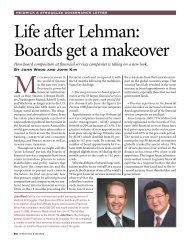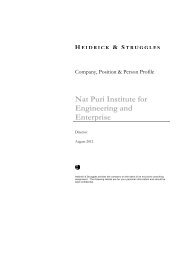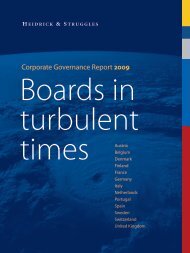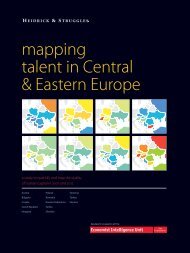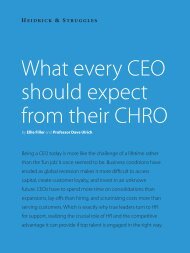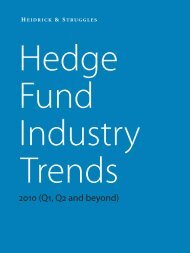Mapping Global Talent: Essays and Insights - Heidrick & Struggles
Mapping Global Talent: Essays and Insights - Heidrick & Struggles
Mapping Global Talent: Essays and Insights - Heidrick & Struggles
You also want an ePaper? Increase the reach of your titles
YUMPU automatically turns print PDFs into web optimized ePapers that Google loves.
Consumer<br />
I shop<br />
therefore I am<br />
Torrey Foster<br />
Consumer practice<br />
tfoster@heidrick.com<br />
<strong>Heidrick</strong> & <strong>Struggles</strong> <strong>Mapping</strong> <strong>Global</strong> <strong>Talent</strong>: <strong>Essays</strong> <strong>and</strong> <strong>Insights</strong><br />
How do you cater to a fickle global<br />
consumer who wants the latest <strong>and</strong> greatest<br />
product for half the price? That is the<br />
question troubling the consumer industry.<br />
Higher levels of discretionary income<br />
with the rise of the middle classes in India<br />
<strong>and</strong> China, combined with ever more<br />
sophisticated consumer tastes, have created<br />
a world where the customer is king (but<br />
always on the look out for a bigger, better<br />
value crown!)<br />
The growing spending power of the developing world<br />
is startling. Today in China the middle class numbers<br />
over 300 million people – that is the same figure as the<br />
current population of the USA. Meanwhile, assuming<br />
steady growth over two decades, India is poised to<br />
overtake Germany as the world’s fifth-biggest consumer<br />
market by 2025.<br />
The developed world cannot match this aggressive<br />
consumerism, but the next five years will see a rise in<br />
tempo as key retail giants fight over a population that is<br />
developing ever more precise ideas of what they want to<br />
spend their money on. The pressures this consumerism<br />
puts on product development, supply chain <strong>and</strong> price<br />
has resulted in strong retail concentration<br />
– for example, in the US, Home Depot <strong>and</strong> Sears<br />
hold sway in the homeware arena, in the UK grocery<br />
store Tesco is the leader, while Carrefour dominates in<br />
France.<br />
These giants expect the very latest in product<br />
development, durability, design <strong>and</strong> price <strong>and</strong><br />
small scale suppliers – finding it hard to keep up<br />
– are increasingly being incorporated into larger<br />
conglomerates with only the Nestlés, the PepsiCos <strong>and</strong><br />
the Krafts able to square up to the big retail firms.<br />
In talent terms this never-ending drive for innovation<br />
will see an exponential increase in the value of R&D<br />
expertise. The pipeline must be primed to produce a<br />
constant stream of new products that will impress the<br />
consumer. Throwing money at innovation isn’t the<br />
solution – many large companies have been tripped up<br />
by this in the past <strong>and</strong> have in turn been outsmarted<br />
by smaller, more nimble competitors. Outsourcing will<br />
become an important pressure valve, as some companies<br />
are already finding to their advantage. At Procter &<br />
Gamble, 35% of all its new products have elements that<br />
originate from outside the company, up from about 15%<br />
in 2000. They say this kind of collaboration has seen<br />
R&D productivity increase by nearly 60%, while R&D<br />
investment as a percentage of sales has fallen from 4.8%<br />
in 2000 to 3.4% today.




